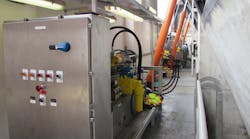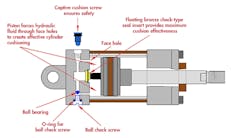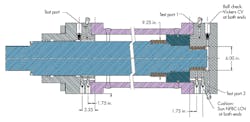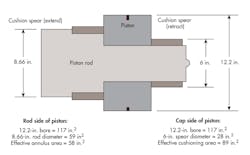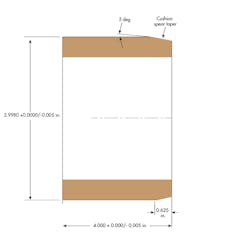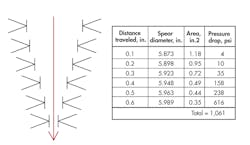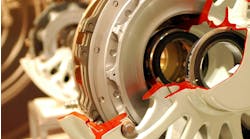Progressive Cushioning for Hydraulic Cylinders
Hydraulic cylinder cushions have been an inexpensive option available on pneumatic and hydraulic cylinders for more than 100 years. It gets down to a simple, machined extension of the piston rod that can decelerate a load during the last few inches of stroke. This deceleration process is automatic, adjustable, and requires no maintenance. It’s an elegant, cost-effective solution if properly executed. Progressive cushioning relies on the same basic principles but uses additional features for greater effectiveness.
Why would you need it? The advantages of progressive cushioning are best realized when you have a very large, heavy structure, such as a flood gate, navigational lock gate, or movable bridge span powered by a hydraulic system. If you are designing such a system, the obvious need to decelerate and stop the structure from moving at each end of the cycle can be accomplished in many ways. Gradually reducing hydraulic fluid flow near the end of stroke can be achieved with various valve circuits, but they all rely on some form of electrical control system or limit switch to initiate and control the deceleration process.
The problem is that sometimes limit switches and control systems fail to operate. There’s little need to explain the effects of what happens when a heavy structure fails to decelerate and slams into its abutment. The resulting damage can be anywhere from mildly annoying to catastrophic.
Why not just specify a standard cylinder cushion option and be done with it? Most cylinder manufacturers’ standard cushion option does not provide progressive deceleration and may be inadequate for properly stopping a heavy runaway structure. A multistage cushioning design, however, provides progressively adjustable deceleration. The structure can be intentionally driven to the end of its cycle without any need for control valve deceleration.
Progressive cushioning doesn’t eliminate the need for control valves, but it provides an extra measure of safety by preventing a large, heavy structure from slamming into a hard stop at either end of its cycle. Shock absorbers can accomplish the same objective, but they are not part of the hydraulic systems, so they are beyond the scope of this discussion.
The Concept of Progressive Hydraulic Cylinder Cushioning
Standard hydraulic cylinder cushioning provides a simple restriction of return flow from the cylinder during the last inch or so of stroke at either or both ends. A spear fixed to the end of the cylinder’s piston rod makes contact with a closely fitted hole in the end cap of the cylinder. The return fluid is forced through a smaller hole fitted with an adjustable needle valve that reduces (regulates) rod velocity until the piston bottoms out. Increased pressure caused by the restriction of the return fluid is the mechanism for slowing the load, (Fig. 2).
2. Standard hydraulic cylinder cushioning provides a simple restriction of return flow from the cylinder during the last inch or so of stroke at either or both ends.
A check valve installed opposite this needle valve allows unrestricted flow in the opposite direction so incoming fluid can act on the full area of the piston. The shortcomings of standard cushions for heavy civil projects are the short length of the cushion spear and the use of a one-size-fits-all adjustable needle valve. These needle valves often are sized for a much larger flow and not able to be properly adjusted.
The progressive design expands on standard cushion options using longer cushion spears and multiple needle valves arranged in a manner that gradually reduces the number of available needle valves in the return-fluid flow path (Fig. 3). Arranging the needle valves in this way allows you to program the deceleration profile to fit a particular application. Final tweaking different parts of the program profile are possible in ultimately small increments via individual needle valves.
3. Progressive cushioning expands on standard cushioning by using longer cushion spears and multiple needle valves that gradually increase the restriction in the fluid’s return-flow path.
Cushion Spear Length
Three characteristics are key to designing progressive hydraulic cylinder cushions to achieve maximum results:
- length of the cushion spear,
- calculating the load to be decelerated, and
- sizing needle valves for optimum flow control.
Cushion spear length is important because most civil engineering applications require cylinders to have reserve stroke. This makes the powered structure come to its rest position prior to the cylinder bottoming out. It’s important during installation to share the reserve stroke between each end of cylinder. Setting of cylinders too shallow could result in the cylinder bottoming out before the span has closed and, conversely, robbing the other end from the effects of the cushions. When more than one cylinder moves the load, it’s important to set them all at the same level so the cushions in all cylinders actuate in unison. Reserve stroke must be shared between both ends of the cylinder to maximize the amount of available cushioning.
Reserve stroke must be taken into account when determining cushion spear length. This unused stroke is no longer available for cushioning and must be deducted from calculations. Reserve strokes as short as ½ to ¾ in. can be specified. Longer lengths should only be considered if you anticipate needing to adjust to the point where the structure might rest.
Selecting cushion length should be approximately the same as the start point of deceleration under normal operation. A good design will have the cushion spear making contact shortly after the normal deceleration point such that no unintended backpressure from the cushioning operation occurs under normal operation. When normal cylinder deceleration takes place, flow exiting the cushion circuit is less than the needle valve setting. The cushion function is always in the background and only comes into play when required by a runaway load causing the return flow to exceed normal conditions.
Generally speaking, most heavy civil engineering applications achieve adequate protection with cushion spears approximately 4 to 6 in. long. Remember that reserve stroke cannot be used for cushioning. Therefore, a reserve stroke of ½ in. would require a 4½-in. cushion spear.
The first ½ to ¾ in. of the spear is usually slightly tapered. This tapering ensures the centering of the spear in the accepting return line passage, but it also serves an important role in initializing deceleration. The most dramatic change in cylinder velocity happens within this first ¾ in. of spear engagement. This is because the orifice area for return fluid goes from 100% to 20% within the first ¾ in. of spear engagement. It’s easy to see how return flow from the cylinder is basically unrestricted until the tapered part of the spear starts closing off the fluid exit path.
The area changes rapidly until the exit passage is blocked and all fluid must flow through the needle valves. After another inch of travel, the exit path through first needle valves gets closed off, and the final creep speed is set by the second needle valve. The deceleration velocity profile can be changed so that more or less change can occur in the first needle valve prior to the final creep speed setting of the second needle valve.
Longer cushion spears can accommodate multiple needle valves. A 6-in. spear with ¾-in. reserve stroke could have as many as four needle valves. A general rule of spacing one needle valve per inch of available cushion spear travel has been effective. With ¾-in. reserve stroke and ¾-in. spear taper, only 4½ in. of travel would be available for a 6-in. spear.
Calculating the Load
Determining the maximum load to be decelerated in a runaway condition may be easier than you think. With a heavy moving structure that’s not stopping because of a limit switch failure, it’s not the structures’ moving mass that’s as important as the hydraulic system horsepower. Runaway conditions caused by moving water, wind, or ice are handled by the normal hydraulic system up to the point of failure of counterbalance valves, relief valves, and basic pressure vessel integrity of the hydraulic system as a whole. If these types of failures are taken account in initial system design, they need not be part of the cushion discussion.
The inertia and mass of the structure are certainly important to overall calculations. However, they are typically only 10% to 20% of the load seen on the cylinder cushions in the scenario where the control system fails to slow down return flow from the cylinders. Most hydraulic systems are designed to output maximum flow until the system pressure causes the variable-displacement pumps to compensate to a lower flow. When the control system fails to regulate pump flow, the cylinder will not start to decelerate until backpressure from the opposite side of the piston exerts a force great enough to cause the hydraulic pump to compensate. Power from the hydraulic pumping system is a much greater force to deal with than load from the moving structure.
Calculating the backpressure required to compensate the pumps is a simple equation based on the effective area of the piston. Keep in mind that piston area is now smaller due to the cushion spear. Figure 4 shows a simplified version of this calculation. Basic fluid power principles of the forces exerted on both sides of the hydraulic cylinder piston must be evaluated.
4. The rod-end piston area of 58 in.2 must work against the 89 in.2 piston area of cap end and develop enough backpressure to raise pressure on the rod end high enough to destroke the pressure-compensated pump.
Use the total available area on the rod-end annulus area including the spear area when making calculations for retracting the cylinder. The force created by pressure on the rod-end side of the piston must be counteracted by the area on the cap-end side minus the spear area. Still referring to Fig. 4, the rod-end piston area of 58 in.2 must work against the 89 in.2 piston area of cap end. This 89 in.2 area must develop enough backpressure to raise pressure on the rod end high enough to de-stroke the pressure-compensated pump. Otherwise, the pump will continue to discharge full flow. When system pressure becomes high enough, the pump will start to compensate, thus reducing the cylinder’s piston velocity.
Sizing Needle Valves
Most standard cylinder cushion needle valves are a one-size-fits-all solution and are not suited for the type of cushioning required for most civil engineering applications. They are generally sized for maximum flows and have coarse thread adjustments that give little adjustability for low-flow situations. Using multiple needle valves can involve very small-diameter orifices that allow greater adjustability at low flows. Most heavy civil engineering moving structures require a creep speed of approximately 10% of the maximum travel speed. Of course this varies for different applications. In general, though, deceleration from 100% speed to 10% speed should occur in 3 to 10 sec. Once creep speed has been achieved, it’s a matter of preference how long to creep to a stop.
After establishing what pressures you anticipate, the adjustable needle valves can be properly sized to provide the necessary change in piston rod velocity. A standard formula is used for calculating flow through a sharp-edged orifice:
A = Q / (24.12 ´ √∆P)
Where A is piston area, in.2
Q is flow, gpm
∆P is backpressure, psid
This formula is also used for calculating the pressure drop across the nose of the cushion spear as it first enters the cushion. Before orifice diameter of the needle valve can be determined you must first calculate the Stage 1 pressure drop created by the initial contact of the cushion spear. This Stage 1 reaction occurs when the high return flow from the cylinder is very quickly restricted to the small orifices defined by the needle valves. The cushion spear is machined with a small taper over the first ½ to ¾ in. of its length (Fig. 5). This taper provides the first stage of backpressure necessary to start destroking the pump.
5. The cushion spear is machined with a small taper over the first ½ to ¾ in. of its length to provide the first stage of backpressure necessary to start destroking the pump.
You can take a snapshot of the available flow area every 1/10-in. in the taper region to calculate pressure drop through the spear taper. Adding these area snapshot pressure drops together yields the pressure drop created during the Stage 1 initial rise in pressure that occurs during the first second of deceleration. Figure 6 shows a model of how this transition from full flow to restricted flow works. Once the main exit path has been closed off by the cushion spear, all fluid must now flow through the needle valves. Pump output flow now starts to decrease, causing the flow through the needle valves to be closer to the 10% target flow.
6. Once the cushion spear closes off the main exit path, all fluid must flow through the needle valves. The backpressure developed decreases pump output.
To size the needle valves, take the intended creep-speed flow and divide by the number of needle valves used; then apply the maximum pressure drop required to keep the pumps compensated. Remember that the cushion spear has already increased pumps’ pressure to the threshold of the compensator setting. Flow decreases further as the spear progresses through the spear cavity, with very little flow being forced through the final needle valve. Size the valves for their mid-range flow capability so you can adjust final speed up or down. Typical needle valve sizing for most civil engineering applications uses approximately a 0.16-in. diameter orifice.
Hydraulic cylinder cushions are a cost-effective method for providing failsafe collision control of heavy moving structures. Progressive cushioning using multiple needle valves in a series cavity arrangement can make the deceleration velocity curve infinitely adjustable to meet the needs of the application.
Mike Hanely is vice president at Electro Hydraulic Machinery Co., Pembroke Park, Fla. For more information, call (954) 981-0023, or visit www.ehmcompany.com.
